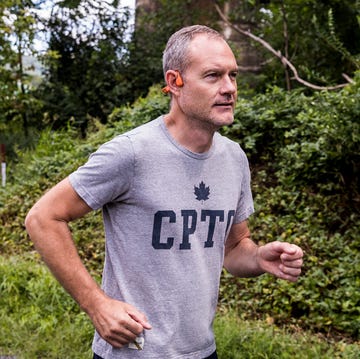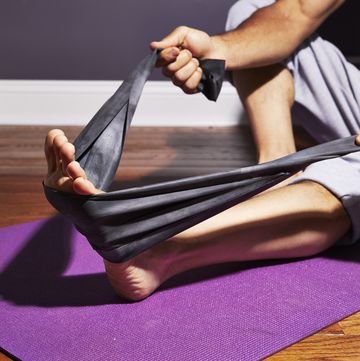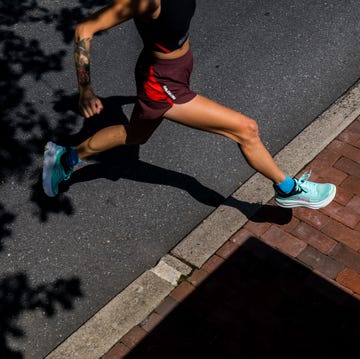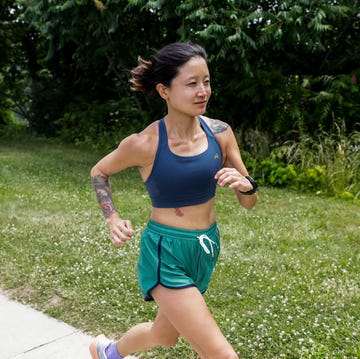Our Runner’s World test team is crew of full-time product testers, editors, photographers, tech gurus, and sneakerheads with a love for running and an obsession with gear. And we’re constantly evaluating the latest shoes, tech, and apparel to determine what is worthy of your sweat and miles. Whether we’re jotting notes during a treadmill session, analyzing data from our Shoe Lab, or hitting the trails on a lunch run, it’s all part of what we affectionately refer to as the Test Zone. Sometimes that means ripping apart shoes to better understand how they work, like when we dissected Nike’s Vaporfly Next% for a peek at the carbon-fiber plate. Or we’ll stick running gloves in the freezer to see which will keep your hands toasty for the longest time. We’ve even used the bacteria found in fermented cheese to most accurately replicate a stinky foot when we tested odor eliminators.
But it’s also about more than evaluations and reviews. As serious runners and gear geeks ourselves, we’re truly curious about shoes, apparel, and accessories and want to answer questions—even bust some myths if we can. During this recent round of testing, we asked, “Is a $70 GPS watch any good?” and wondered whether it’s really worth the price tag to splurge for a jogging stroller with built-in suspension. We checked out some futuristic sunglasses to see if their rain-defying lenses deserved the hype, and we shrunk some of our favorite running shirts to see which ones you actually do need to hang to air dry. (Read on for our findings, because we’ve all accidentally shrunken at least one tee in the dryer.)
And we want to hear from you, our RW+ Members. Is there a gear-related question that you’ve been mulling over on your long runs? Something you’ve heard recently about shoe tech that you think we should test? Maybe it’s simply a new workout product you’ve been eyeing that you want to know more about. No suggestion is too big or too small for the Test Zone. Drop it in the comments section and let us know.
Running in Sunglasses Made for Rain, Shine, or Fog
District Vision claims that its Calm-Tech lenses are the world’s first porous option, able to partially absorb fog and light rain to boost clarity. These work by drawing in moisture from the outer surface of the lenses, which in turn helps prevent water droplets from obstructing your view until the moisture can eventually evaporate. To verify that, runner-in-chief Jeff Dengate spritzed the brand’s Takeyoshi glasses with a fine-mist spray bottle, and the difference was evident: The District Vision glasses dispersed the droplets and minimized the number of hard round edges Jeff saw from behind the lenses. Of course, the surface won’t stay bone-dry in a downpour like, say, during 2018 Boston. But in snow flurries and drizzle, moisture forms beads and dissipates quickly for a much clearer view.
Which Shirt Materials Won’t Shrink in the Dryer?
You’ve probably been there: While taking your clothes out of the dryer, you realize you forgot to pull out your favorite running top, and now it’s a size smaller. But not all running shirts will shrink. To find out which fabrics are most susceptible, we washed five running tees on warm and then dried them on high heat for a full 40-minute cycle at the local laundromat. Two were made of organic fibers, and the other three used polyester.
The Results
- The two organic-fiber shirts suffered the most. Janji’s cotton-and-alpaca Runpaca tee and Tracksmith’s merino wool Harrier long-sleeve both shrank between 1 and 1.5 inches vertically and horizontally. That’s more than a half size.
- The rest of the shirts—from Puma, Hoka One One, and Eddie Bauer and all polyester—didn’t shrink at all.
Bottom Line: Don’t be afraid to dry polyester-based apparel, but take extra care to separate out your shirts made with natural fibers before drying.
This $70 GPS Watch Comes With Compromises, But Impressed Us With Its Accuracy
When we first heard of the sub-$100 Amazfit Bip S, we wondered if it could truly contend with the Garmins of the world. The answer is both yes and no. In testing, we found that the Bip’s connectivity with the phone app was clunky, notifications came up inconsistently, and the screen lacked the sharpness of better models. But, in terms of accuracy, the Bip delivered. As a device that simply records your route via GPS and tracks your heart rate, it’s as on the mark as—if not more so than—some of its pricier competitors.
We know this because we marked off a three-mile course with a measuring wheel and then ran it with the Amazfit Bip S and three other GPS- and HR-enabled devices: the Garmin Forerunner 735XT, the Samsung Galaxy Watch Active, and the Fitbit Charge 4. We used a Wahoo Tickr X heart-rate monitor connected to a Wahoo Elemnt Bolt bike computer to get an accurate HR measurement, because wrist-based monitors are sometimes less accurate. To avoid signal interference, we ran with only two devices at a time.
The Results
- The Amazfit recorded the distance within 0.03 miles and registered the same average heart rate and approximate heart-rate graph as the Wahoo Tickr X.
- The Garmin and Samsung were similarly close, if a little better, pegging the distance within 0.01 and 0.02 miles, respectively.
- The Fitbit Charge 4 was the biggest deviator, recording the distance 0.08 miles too far and a heart rate five beats per minute lower than the other devices.
Bottom line: If you want a GPS watch just to keep tabs on distance and heart rate, spending more won’t necessarily buy you more accurate tracking.
Is a Running Stroller with Suspension Worth the Money?
BOB Gear’s Alterrain stroller is an excellent option for runners who want to sneak in some miles without interrupting their kid’s nap time. But this BOB model originally costs $550, and it’s possible to find other jogging-specific strollers for half as much, or even less. Part of the reason for the price tag is that the Alterrain uses frame-integrated shocks to smooth your little one’s ride (and limit jarring hits from rocks and cracks in the road that can throw off your stride). To find out what degree of bump-smoothing a kid might experience—and whether that suspension was worth the cost—we tested the Alterrain against a similar but less expensive $200 Allen Sports model without suspension.
To do it, we taped a phone-app accelerometer to a 30-pound dumbbell (which simulated the weight of a 3-year-old) and strapped the dumbbell into each stroller. We pumped the pneumatic tires of both up to 30 psi, the recommended value. Then we ran the strollers across 20 meters of small rocks and recorded the maximum vertical G forces of the shaky, short trip. We repeated the test three times.
The Results
- On average, the BOB Alterrain transmitted 2.8 vertical Gs to our dummy passenger.
- The unsuspended model sent 4.4 Gs through the stroller.
- When you take into account that measurable G forces start at one G because we’re all constantly experiencing gravitational force, the BOB rode almost twice as smoothly.
Bottom Line: That amount of vertical G forces is a significant difference, one that our experience shows should keep your child more comfortable over long runs, with fewer disruptions to your stride. If you can afford the suspension, get it.

Morgan is a gear editor who has been with Runner’s World since 2017. She started as an intern ghostwriting The Warmup, a bygone version of the daily RW newsletter. Now, she tests and reviews anything you might find on runners’ feet-from crew socks and compression boots to carbon-plated super shoes.
A lifelong runner and shoe geek, Morgan has been chasing the perfect pair of kicks since she joined her grade school cross-country team. Since then, she ran as a Division I walk-on for the cross-country and track & field teams at the University of Delaware, where she studied English and Biology. She has one full marathon under her belt, and has raced more halfs and 5Ks than she can count.






























